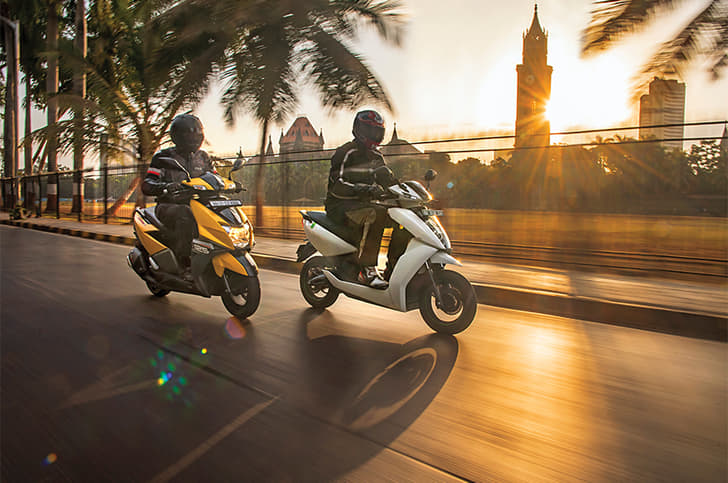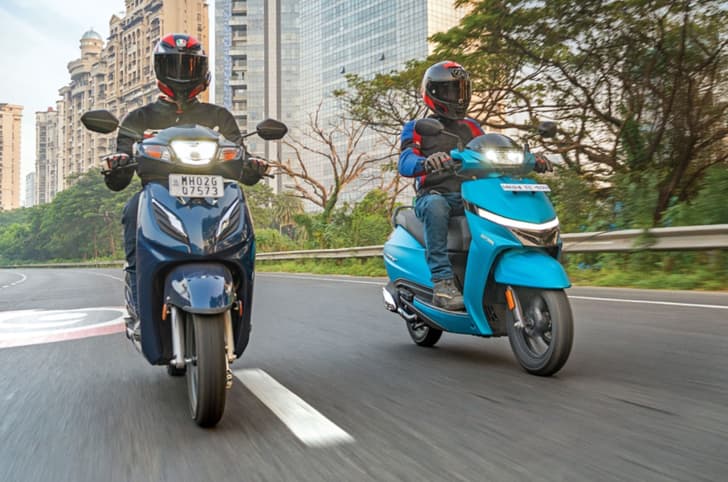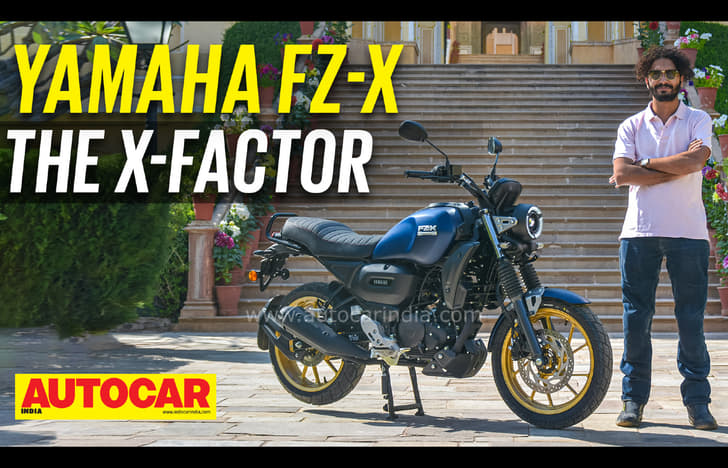I believe you must never compare apples to oranges. Imagine you asked a fruit seller for an apple and he handed you an orange? It just wouldn’t work, would it? Luckily for you apple enthusiasts, that isn’t happening just yet. However, we are rapidly approaching a dilemma in the two-wheeler world, where the electric revolution looms just around the corner and it seems like the comparisons have become inescapable. At this point, any comparison would solely be to discover whether EVs can be a realistic alternative to regular scooters and that’s why we decided it would be fun to pitch India’s best EV against our favourite 125cc scooter. So let’s see how this ‘apple’ compares to that ‘orange’!
E-revolution
We first rode the Ather 450 last year and it changed our perception of what an e-scooter should be like, and in terms of performance, we found it to be equivalent to a 125cc scooter. It’s taken a long time, but we finally got to ride it back to back with a conventional scooter to check if that’s true.
Before we head any further, the huge price difference between the two has to be addressed. The Ather’s Rs 1.23 lakh (on-road, Bengaluru) price, makes it cost nearly Rs 40,000 more than the TVS, but it targets niche customers willing to pay a premium for bits like aluminium components and fancy gadgetry. A more price-effective Ather is in the works, but that’s a long time away, so we decided to ignore the prices and dive straight into the differences.
IQ test
The Ather 450 is a smart scooter. Its large, 7.0-inch, full-colour capacitive touchscreen is so capable, it’s more of a user interface than instrumentation. It even comes with a SIM card that provides the required internet connection for all the connected features, as well as navigation. Additionally, pairing it to the Ather app on your smartphone allows you to track its location, send it your desired destination for navigation even before you get on it, check the available range and more.
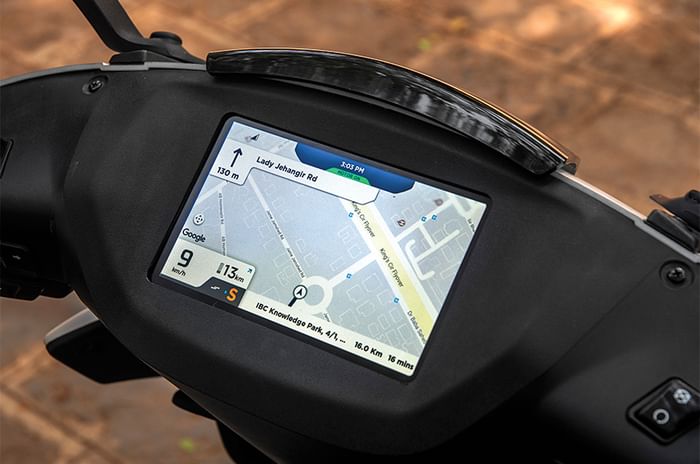
The Ather 450's interface is the most advanced on a scooter in India.
The feature list doesn’t end there though. The 450 also gets auto-cancelling turn signals and guide-me-home lights, as well as reverse park assist, which as the name suggests, slowly moves the scooter backwards to help while parking. The last time I experienced that was on Honda’s Goldwing and it costs Rs 27 lakh! If I had to nitpick, the touchscreen on the 450 could have been a little more responsive.
By comparison, the Ntorq is not touch-responsive at all. Still, it uses a fully digital cluster that has segment-first features like Bluetooth and a basic navigation system. But while this one is the most advanced you’ll find on a petrol-powered scooter, it’s far more basic than the Ather’s. However, it does have an interesting Sport mode where it displays your lap times, top speed and more.

The Ntorq's instrument cluster isn't as fancy, but has some nifty features.
Design
With the 450, Ather believes it has created a competitor to a conventional scooter and not some freaky experimental alternative, and the way it’s styled validates that. Aside from the artistically designed exposed frame that holds the seat mount, it has a familiar, narrow and tall stance that is mildly reminiscent of Aprilia’s SR range. We parked it in a busy two-wheeler parking facility and the Ather blended in a little too easily, which is a pity. A few basic gloss colours options like red, blue and yellow could really brighten things up.
The designers at TVS, meanwhile, managed to find the sweet spot between a sporty and family-oriented scooter. The wide front-end, and sharp creases and corners make it appealing to the youth, while the low seat height and large footboard are appreciated by the slightly older audience. The Ntorq gets an LED tail-light, DRL and underseat light, however, every other light continues to be halogen-type, while the Ather uses LEDs all around. Unlike the monochrome Ather, the TVS offers a variety of striking matte and gloss colour schemes.
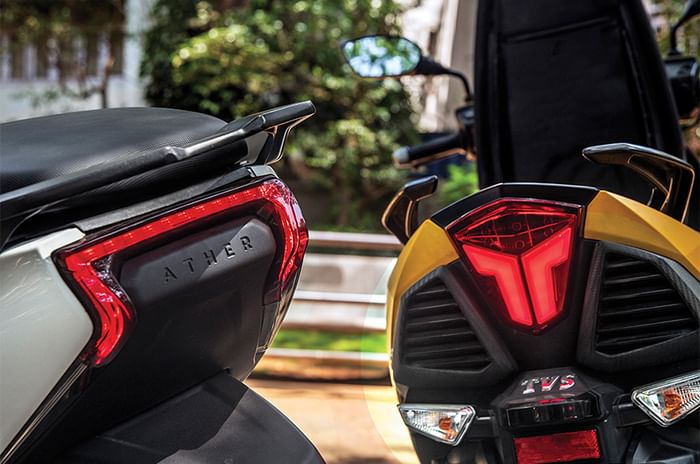
Sharp styling on both scooters, but the Ather is a tad more slick.
Moving forward
On the road is where a clear distinction emerges between the two scooters. While the TVS, at 9.4hp, has a 2.1hp advantage, the Ather makes nearly double the torque at 20.5Nm. However, both scooters aren’t that far off when it comes to their weights; the Ather, at 118kg, is just 2kg heavier than the Ntorq. The Ather 450 has two modes – Ride and Sport. We spent most of our time in the latter because ‘Ride’ holds back the performance quite significantly. That said, the scooter did force itself into ‘Ride’ once the battery percentage dropped below 20 percent, to conserve every last bit of charge it had left.
In Sport mode, it was neck and neck with TVS up to 60kph in our acceleration tests. However, after 60kph, the Ntorq’s 125cc, petrol engine is a lot more potent. It reaches 80kph in 16.78sec, while the Ather takes 21.45sec. The Ather also loses steam much quicker,with a Vbox-indicated top speed of 79.9kph, while the Ntorq climbs all the way to 95.4kph.
One interesting discovery we made was that, like a lot of battery-powered machines, the Ather’s performance drops by a noticeable margin when it’s low on charge. For instance, with charge at 35 percent, we found that going from 30-70kph took 12.16sec – nearly 2sec slower than when on a full charge. What we also noticed is that thanks to the lack of noise and the complete smoothness, riding the Ather in traffic is a much calmer experience and that’s something we think we’d grow to love over daily commutes.
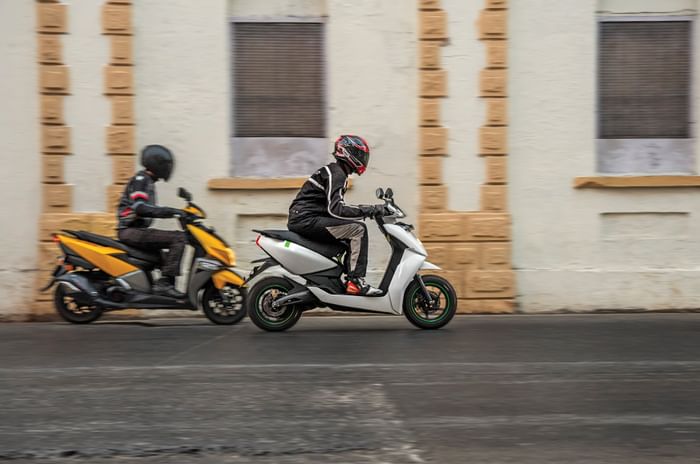
Stop and go
The 450 comes equipped with a rear disc brake and that is quite uncommon on scooters in India. While it’s a nice touch, it locks up easily despite having CBS. But Ather says it is working on the fine-tuning. The Ntorq we tested didn’t have CBS or a rear disc, but it still managed to go from 60-0kph in an identical distance of 20.3m as the Ather.
Both scooters also run a telescopic fork and monoshock setup, with 12-inch wheels at either end. While the ride quality on both is biased more towards sporty than comfy, it never feels harshly stiff on either, but it’s the TVS that offers a slightly more comfortable ride. As speeds get a bit higher, it is the Ntorq again that feels more stable, partly thanks to the wider rubber on offer.
Is it time?
There’s no denying that EVs are the way forward and the Ather, with its impressive quality, long features list and sprightly performance, gives a good taste of what lies ahead. However, putting it up against one of the best 125cc scooters has revealed two major obstacles. The first one is the range, or the lack thereof. Ather’s claim of 60-70km is realistic and it will be just about enough for the average big city commute, but if you find yourself having to run any extra distance, range anxiety becomes very real. Secondly, the electric infrastructure is very under-developed. This is something Ather is working on as it expands to different cities, but there’s only so much one company can do without active government intervention. Ather’s infrastructure expansion is happening very slowly, and at present, it is only Bengaluru and Chennai where the company’s scooters and fast charging points (also known as the Ather Grid) are available.
As things stand in 2019, the Ather is a fabulous machine, and in many ways it is the more desirable one too. However, until EVs can offer a realistic range of 120-150km at a comparable price, internal combustion scooters still have the edge.

| Specifications | ||
|---|---|---|
| Ather 450 | TVS Ntorq 125 | |
| Engine layout | Brushless DC Motor | Single-cylinder |
| Displacement | NA | 124.7cc |
| Power | 5.4kW/7.34hp | 9.4hp at 7500rpm |
| Torque | 20.5Nm | 10.5Nm at 5500rpm |
| Wheelbase | 1278mm | 1285mm |
| Ground clearance | 160mm | 155mm |
| Fuel tank | NA | 5 litres |
| Kerb weight | 118kg | 116.1kg |
| Front suspension | Telescopic fork | Telescopic fork |
| Rear suspension | Monoshock | Monoshock |
| Front brake | Disc | Disc |
| Rear brake | Disc | Drum |
| Tyre size (f/r) | 90/90-12 / 90/90-12 | 100/80-12 / 110/80-12 |
| Performance | ||
|---|---|---|
| Ather 450 | TVS Ntorq 125 | |
| 20-50kph | 4.13s | 4.41s |
| 30-70kph | 10.19s | 10.06s |
| 50-80kph | 14.34s | 11.52s |
| 0-60kph | 8.28s | 8.11s |
| 0-80kph | 21.45s | 16.78s |
| 60-0kph (distance) | 20.32m | 20.34m |

